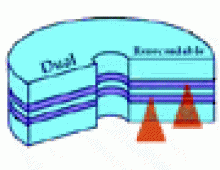
Rewritable DVD+RW Double Layer Format to Be Finalized by Year-End
The DVD+RW Alliance has announced that it has started discussions for a new rewritable double layer DVD+RW DL standard that will be finalized by year end.
Using a double layer DVD+RW DL disc a consumer can write and re-write up to 8.5 Gbytes of information or up to 4 hours of DVD quality time-shifting recording onto a single 12 cm disc.
"8.5 GB Double layer DVD recording is quite popular amongst PC users and is now standard on any new DVD writer," said Frank Simonis, Chair of the DVD+RW Alliance Product Promotions Group and Strategic Marketing Director for Philips Optical Storage. "Rewritable double layer DVD+RW DL will give consumers the extra recording time for consumer video recording and especially the 8cm discs for DVD camcorders."
Following the technical background used for the development of the recordable dual layer disc (DVD+R DL), Philips had to face significant issues when considering the DVD+RW DL concept. Two different layers had to be mounted together and offer adequate optical characteristics in terms of light (laser) reflectivity and transmission at the same time.
The upper stack (L0) of such disc needed to be highly transparent, in order to be able to read and write in the lower (L1) stack. So the challenge here was to find a balance between optical transmission and sufficient cooling of the phase-change material used for rewritable media. Making the layer thinner helps transmission but it would require a thinner heat sink, increasing the risk of making the medium non-erasable due to quick recrystallization of the amorphous marks (data) on the disc.
On the other hand, the lower disc stack (L1) should be highly reflective and of course should be sensitive enough to be recorded with a low-power laser.
With those issues in mind and also considering that phase-change materials have a much higher absorption than the dyes in write-once discs, it would not be possible to design a DVD rewritable dual-layer system that complies to the DVD standard, which requires a 18% reflectivity. As a result, the DVD+RW DL media would not be compatible to current DVD players, and a hardware upgrade would be an essential before using it.
During the ISOM/ODS conference Hawaii (July 2005), Philips Research presented its progress in rewriteable double layer DVD+RW DL recording. According to the announcements, a good performance was presented for recording at 2.4x as well as 4x recording speeds; for both layers low jitter and high modulation values were achieved. Effective reflection of the media is around 5-7 %.
The DVD+RW DL discs are mainly addressed for use in DVD camcorders (8cm discs).
On September 29 the DVD+RW Alliance will update these consumer electronics and PC drive manufacturers on the proposed details of the rewritable double layer standard during a technical seminar in Tokyo.
"8.5 GB Double layer DVD recording is quite popular amongst PC users and is now standard on any new DVD writer," said Frank Simonis, Chair of the DVD+RW Alliance Product Promotions Group and Strategic Marketing Director for Philips Optical Storage. "Rewritable double layer DVD+RW DL will give consumers the extra recording time for consumer video recording and especially the 8cm discs for DVD camcorders."
Following the technical background used for the development of the recordable dual layer disc (DVD+R DL), Philips had to face significant issues when considering the DVD+RW DL concept. Two different layers had to be mounted together and offer adequate optical characteristics in terms of light (laser) reflectivity and transmission at the same time.
The upper stack (L0) of such disc needed to be highly transparent, in order to be able to read and write in the lower (L1) stack. So the challenge here was to find a balance between optical transmission and sufficient cooling of the phase-change material used for rewritable media. Making the layer thinner helps transmission but it would require a thinner heat sink, increasing the risk of making the medium non-erasable due to quick recrystallization of the amorphous marks (data) on the disc.
On the other hand, the lower disc stack (L1) should be highly reflective and of course should be sensitive enough to be recorded with a low-power laser.
With those issues in mind and also considering that phase-change materials have a much higher absorption than the dyes in write-once discs, it would not be possible to design a DVD rewritable dual-layer system that complies to the DVD standard, which requires a 18% reflectivity. As a result, the DVD+RW DL media would not be compatible to current DVD players, and a hardware upgrade would be an essential before using it.
During the ISOM/ODS conference Hawaii (July 2005), Philips Research presented its progress in rewriteable double layer DVD+RW DL recording. According to the announcements, a good performance was presented for recording at 2.4x as well as 4x recording speeds; for both layers low jitter and high modulation values were achieved. Effective reflection of the media is around 5-7 %.
The DVD+RW DL discs are mainly addressed for use in DVD camcorders (8cm discs).
On September 29 the DVD+RW Alliance will update these consumer electronics and PC drive manufacturers on the proposed details of the rewritable double layer standard during a technical seminar in Tokyo.




















